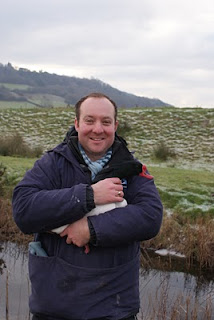 |
| BX - one of five chicks ringed in the Avon Gorge in 2010. Photo by Ed Drewitt. |
Of my peregrines that have been re-sighted so far, most have been quite close to Bath and Bristol, near where we ringed them. For example, one was seen with a female partner 15km south of Bristol from where it was ringed two years later; another is now the breeding male at a nest in Bath where it hatched; and a third individual was re-seen later in the autumn at the site where it was ringed and had fledged earlier that year.
Our furthest travelled bird however goes to the following individual. One of the young peregrines we ringed in the Avon Gorge in 2010 was also filmed for the BBC's Springwatch.
He was given a blue colour-ring with black letters, BT (his sibling BX is in the photo above)
He was spotted and photographed by Michael Colquhoun in the Malvern Hills, Worcestershire back in April 2011. This was exciting news and it was great to know one of the chicks had ventured so far.
 |
| BT in April, 2011 - now is partial adult plumage in the Malvern Hills. Photo by Michael Colquhoun |
 |
| BT's colour ring clearly visible. Photo by Michael Colquhoun. |
He had been dead for four days before being found (as indicated by the development of moaggots). He was taken to a vet by the police for an x-ray to confirm he hadn't been shot. He had been found below power lines and seems likely he had died from some interaction with these.
 |
| BT's colour ring. Photo by Jason Kernohan |
 |
| BT's metal BTO ring. Photo by Jason Kernohan. |
Despite this young bird's death I'm pleased we know his final outcome and where he travelled. It helps build up a bigger picture of what peregrines do when they fledge. It's interesting that we've not heard from the other four chicks that were in that same family. Yet we have heard from this individual twice! Hopefully as the other four (assuming they are all alive) begin breeding they will be spotted and identified by myself or someone else watching them.








